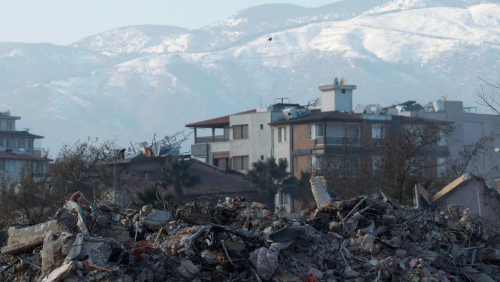The Environmental Impact and Aftermath of the Turkey-Syria Earthquakes
February 27, 2023 by Eli Rivas

Rubble from collapsed and heavily damaged buildings in the foreground with snowcapped mountains visible in the background.
On February 6, 2023, a colossal 7.8 magnitude earthquake, followed shortly after by a 7.6 magnitude aftershock struck Turkey, its epicenter closest to the city of Kahramanmaras. Over 50,000 people have died in large part due to building collapses, with casualties stretching from Turkey to neighboring Syria.[i] Beyond the death toll and destruction, the earthquake has also created wider environmental concerns, both immediate and long-term.
The seismic activity severely damaged water and sanitation infrastructure in the region.[ii] As organizations like the World Health Organization (WHO) and the United States’ Federal Emergency Management Agency have identified, disruption to water services caused by earthquakes “increases the risk of waterborne diseases and outbreaks of communicable diseases,” and survivors should be immediately assisted with the location and provision of clean water.[iii]Turkish health authorities have been able to offer tetanus shots for those who request it, with the WHO providing additional support in monitoring waterborne diseases.[iv] The United Nations is also providing aid, including the distribution of cholera tests.[v] However, temporary drinking water sources and sanitary bathing and restroom facilities have been too few to support those affected,[vi] and repair of critical water infrastructure will remain a long-term problem.
The earthquake has also created geological problems. The coastal city of Iskenderun experienced subsidence, which in turn led to flooding in the region.[vii] Some coastal communities have even experienced encroachment from sea water as far as 200 meters inland.[viii] In addition to the threat of waterborne diseases described previously, many hillsides are at risk of landslip, and satellite imagery shows evidence of numerous landslides and rockfalls.[ix] The effect of the geological problems could create additional impacts on infrastructure, with roads and pipelines needing to be rebuilt and redirected, and rural communities will likely be disproportionately affected in comparison to urban communities.[x]
The disaster in Kahramanmaras also begs a deeper question: how do humans create communities that can exist in harmony with the inherent challenges that the environment presents? In particular, many cities that exist in earthquake-prone communities must take seriously the challenge of constructing homes and buildings made to withstand significant seismic activity. After destructive earthquakes in 1999 and 2011, Turkish authorities tightened construction regulations in order to have more buildings retrofitted for earthquakes.[xi] Turkish officials have responded to the numerous collapsed buildings in the most recent quake by investigating over 130 people involved in the construction of those buildings and even detaining some contractors they believe to be at fault.[xii] Even so, there is also evidence that the regulations themselves were not stringently enforced, which may place some part of the blame back on the parts of the Turkish government responsible for enforcing them.[xiii]
There is no obvious answer to the question of the humans’ relationship with their environment, but law can be one tool in facing down challenges, especially where legislation or regulations can be created or enforced to protect people, critical infrastructure, and the environment. The Turkey-Syria earthquakes underscore the vital importance of working towards an answer to that question.
[i] Death toll climbs above 50,000 after Turkey, Syria earthquakes, Al Jazeera (Feb. 25, 2023), https://www.aljazeera.com/news/2023/2/25/death-toll-climbs-above-50000-after-turkey-syria-earthquakes#:~:text=In%20Turkey%20alone%2C%2044%2C218%20people,toll%20in%20Syria%20was%205%2C914.
[ii] Henriette Chacar, Disease the new threat as Turkey faces post-quake water shortage, Reuters (Feb. 15, 2023, 9:06 AM), https://www.reuters.com/world/middle-east/disease-new-threat-turkey-faces-post-quake-water-shortage-2023-02-15/.
[iii] See id (internal quotations omitted); Jaclyn Diaz, The earthquake in Turkey and Syria offers lessons and reminders for disaster response, NPR (Feb. 16, 2023, 5:01 AM), https://www.npr.org/2023/02/16/1156636019/the-earthquake-in-turkey-and-syria-offers-lessons-and-reminders-for-disaster-res.
[iv] Diaz, supra note 3.
[v] Tiffany Wertheimer, Turkey earthquake: Girl survives 10 days under quake rubble, BBC News (Feb. 16, 2023), https://www.bbc.com/news/world-europe-64662941.
[vi] Chacar, supra note 2.
[vii] Kate Ravilious, Geological impact of Turkey-Syria earthquake slowly comes into focus, The Guardian (Feb. 10, 2023, 6:29 AM), https://www.theguardian.com/world/2023/feb/10/geological-impact-of-turkey-syria-earthquake-slowly-comes-into-focus.
[viii] Id.
[ix] Id.
[x] Id.
[xi] Jake Horton & William Armstrong, Turkey earthquake: Why did so many buildings collapse?, BBC News (Feb. 9, 2023), https://www.bbc.com/news/64568826; Diaz, supra note 3.
[xii] Justin Spike et. al., Turkey probes contractors as earthquake deaths pass 33,000, Associated Press (Feb. 12, 2023), https://apnews.com/article/2023-turkey-syria-earthquake-government-business-658d897fe02316c474a8cc8078b690a3.
[xiii] Spike et. al., supra note 12; Horton & Armstrong, supra note 11.

